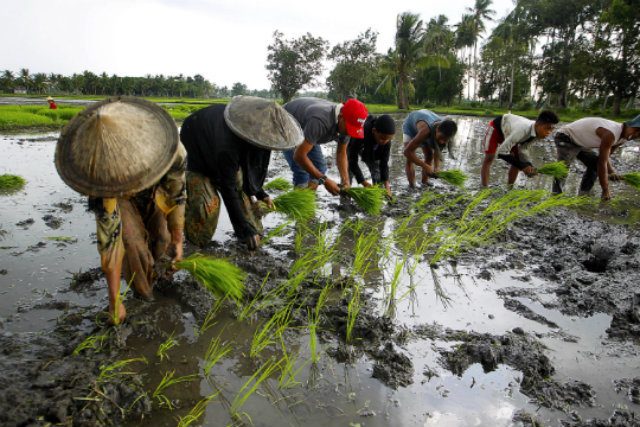SUMMARY
This is AI generated summarization, which may have errors. For context, always refer to the full article.


MANILA, Philippines – Intense heat and lack of irrigation caused by the dry spell in several provinces dragged down agricultural production in the second quarter of 2015.
A report by the Philippine Statistics Authority (PSA) shows that agricultural production from April to June 2015 contracted by 0.37%. Compare this to the same period last year when production grew by 2.73%.
Read the entire report here:
” style=”text-decoration: underline;” >Performance of Philippine Agriculture Report April-June 2015
The PSA attributed this decline to the “intense heat during the quarter” which negatively affected the performance of the crops and fisheries subsectors. The dry spell is an effect of the El Niño phenomenon currently affecting different parts of the world.
However, the livestock and poultry sectors performed well despite the heat, registering growths in production during these months.
As a whole, agriculture earned P372.4 billion during the quarter – 5.21% lower than last year’s earnings. But if the performance of agriculture during the first quarter is also considered, data shows the sector grew by 0.73% during the first half of the year.
A major contributor to the downturn in agriculture was the effect of the dry spell on crops like palay and corn, said the PSA. Crops contribute 49.80% of total agricultural production. (READ: DA to farmers: Use rainy season to fight El Niño)
Palay production from April to June was 2.88% lower than production during those months last year. Corn production decreased by 15.76%.
Coconut production continued its downward trend. Output declined by 0.81% due to Typhoons Glenda, Ruby and Seniang, as well as the continued infestation of coconut scale insects in some provinces.
Other crops to suffer declines in production due to intense heat are sugarcane (-15.39%), banana (-0.18%), and coffee (-5.70%).
Growth for other crops
Not all crops suffered from the dry spell.
Due to increased harvested area and intensive farming practices in Region 4A (Calabarzon), Bicol, Eastern Visayas, Bukidnon and Misamis Oriental, pineapple production grew by 2.76%.
Mango production increased by 4.09% due to flower-inducing practices in Iloilo, Negros Oriental, Calabarzon, and Central Visayas that increased fruit harvests.
Sunny weather that prevailed during those months also led to more fruits harvested in Misamis Occidental, Misamis Oriental, Lanao del Norte and Bukidnon.
Mongo production expanded by 5.6% due in part to seed assistance programs in Isabela province, increased harvested areas in Tarlac and Iloilo, and better yield in Antique.
Other crops to register production growth are cassava (5.45%), camote (9.93%), garlic (1.52%), cabbage (1.11%), egg plant (1.76%), and abaca (2.48%).
In all, the gross value of output for crops for the second quarter – P200.4 billion – is 9.64% lower than last year’s level. For the first half of 2015, gross output of crops declined by 0.54%. (READ: DA awaiting P939 million budget for El Niño efforts)
Ongoing dry spell
Fisheries production, which contributes 18.79% to total agricultural production, declined by 1.53% in the second quarter of the year.
Intense heat led to lower production of milkfish, tilapia, roundscad, and skipjack, according to PSA data. Second quarter and first quarter data combined show that fisheries production for the first half of 2015 declined by 2.12%.
The PSA said palay production suffered in part due to faulty irrigation systems.
In SOCCSKARGEN for example, the closure of the NIA Aris DAM 2 for rehabilitation of damaged canals forced farmers to delay cropping in South Cotabato.
Lack of water in irrigation systems and intense heat also led to lower yield and smaller harvested area in Mindoro provinces, Caraga, Bukidnon, and Western Visayas.
In Misamis Oriental, palay production suffered from the conversion of rice fields into residential areas.
Corn’s downward turn was also attributed to lack of water due to intense heat that led to decrease in harvest area and yield in SOCCSKARGEN, the Davao provinces, Cagayan Valley, Northern Mindanao and Bicol region.
There are 13 provinces that continue to experience dry spell, according to an August bulletin by the Philippine Atmospheric, Geophysical, and Astronomical Services Administration (PAGASA).
These are:
- Aurora
- Bohol
- Camarines Norte
- Camiguin
- Catanduanes
- Laguna
- Marinduque
- Misamis Oriental
- Occidental Mindoro
- Oriental Mindoro
- Quezon
- Quirino
- Siquijor
Of these, Bohol and Camarines are likely to continue experiencing the dry spell, says PAGASA. The rest are “likely to improve.” – Rappler.com
Add a comment
How does this make you feel?
There are no comments yet. Add your comment to start the conversation.